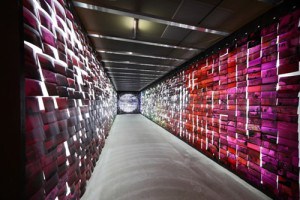Taking advantage of the dimensions of a standard shipping container (12.0 meters long x 2.4m wide x 2.8m high), the power and potential of art can be enjoyed in various forms, from two- and three-dimensional works, motion images and installations, to traditional arts and interactive arts.
This international competition, which employs the interior of a shipping container as a display space, is open to applications from the public and has been the main feature of Kobe Biennale since its launching. Shipping containers which migrate within and between countries symbolize Kobe, that has long been developing as a port city, through the constant coming and going of people, goods, and information. For the competition in 2011 entries came from various genres including design and architecture.
A wide variety of works from professionals and nonprofessionals are welcome.
Theme “Saku”
By taking advantage of Kobe’s pioneer spirit and long-cultivated cultural strengths in diverse areas, KOBE Biennale has been dedicated to the creation of an attractive city through the support of diverse cultural activities that add color to society and give birth to unprecedented artistic expression and values.
Today, people emphasize interpersonal relationships in a struggle to reconstruct the trust that has collapsed in both international society and local communities. Under such circumstances, we should make efforts–and start such efforts today–to make our society a better place so that people believe in a bright future and succeed in achieving their respective desires and dreams. We must discover a firm belief by which we can make it through combined effort and wisdom.
Building on KOBE Biennale’s past achievements attained through the 2007 “Deai” (Encounter~People, Community, Arts) project, the 2009 “Wa” (harmony) project, and the 2011 “Kira” (sparkle) project, we have set our new goal for KOBE Biennale 2013, with “Saku” (meaning “blooming”) as the theme for the 4th KOBE Biennale. What will each person see beyond the world? We hope to find blooming flowers, no matter how small, and we have a lot of hope for each of these blossoms.
Exhibition period
October 1 (Tuesday) through December 1 (Sunday), 2013 (62 days)
Eligibility
All nationalities, ages, individuals or groups are eligible.
Works must be original and never been presented elsewhere before.
However, works whose presentation has been limited to applicants’ personal websites are still eligible.
Prizes and cash awards
Kobe Biennale Grand Prize (1) consists of a trophy, diploma and cash award of ¥3,000,000.
Runner-up prizes (2) consist of diploma and cash award of ¥1,000,000, for each winner.
Honorable mentions (22) consist of diploma and cash award of ¥300,000 for each winner.*The above prizes do not involve purchasing the works.
*The above prizes will be chosen from the 25 awarded works.
*The cash awards are inclusive of taxes.
(Withholding income tax will be deducted.)
*Winners who reside outside Japan may be able to apply tax treaties between Japan and their countries of residence.
*Winners who reside outside Japan will receive supplemental amounts of ¥100,000 to ¥300,000 (depending on the areas) to their cash awards to cover their travel expenses.
*Should the display of winning works become impossible due to circumstances for which the applicant is responsible, the cash awards (including the payments for travel expenses) shall be returned immediately.
Jury members
SAKAMURA Ken (Professor, the Interfaculty Initiative in Information Studies at the Graduate School of the University of Tokyo)
NAKAYA Hide (Chief Commentator at NHK)
MATSUI Shiro (Professor, Faculty of Fine Arts, Kyoto City University of Arts)
MINO Yutaka (Director, Hyogo Prefectural Museum of Art)
YOSHIDA Hiromi (General Producer, KOBE Biennale 2013)
Yong-woo Lee (Executive Vice President, the Gwangju Biennale Foundation)
Application period
February 4 (Monday) to no later than February 13 (Wednesday), 2013
NOTE: a submission/judging fee is payable


